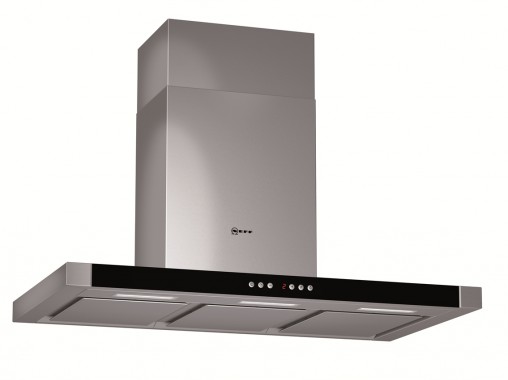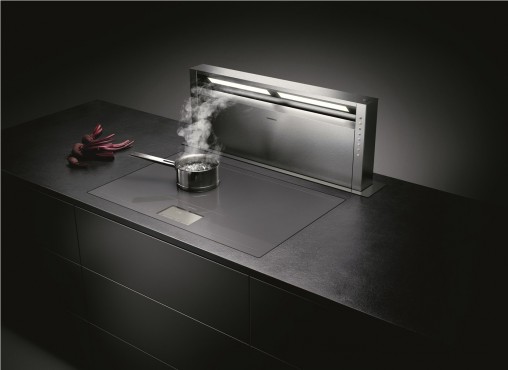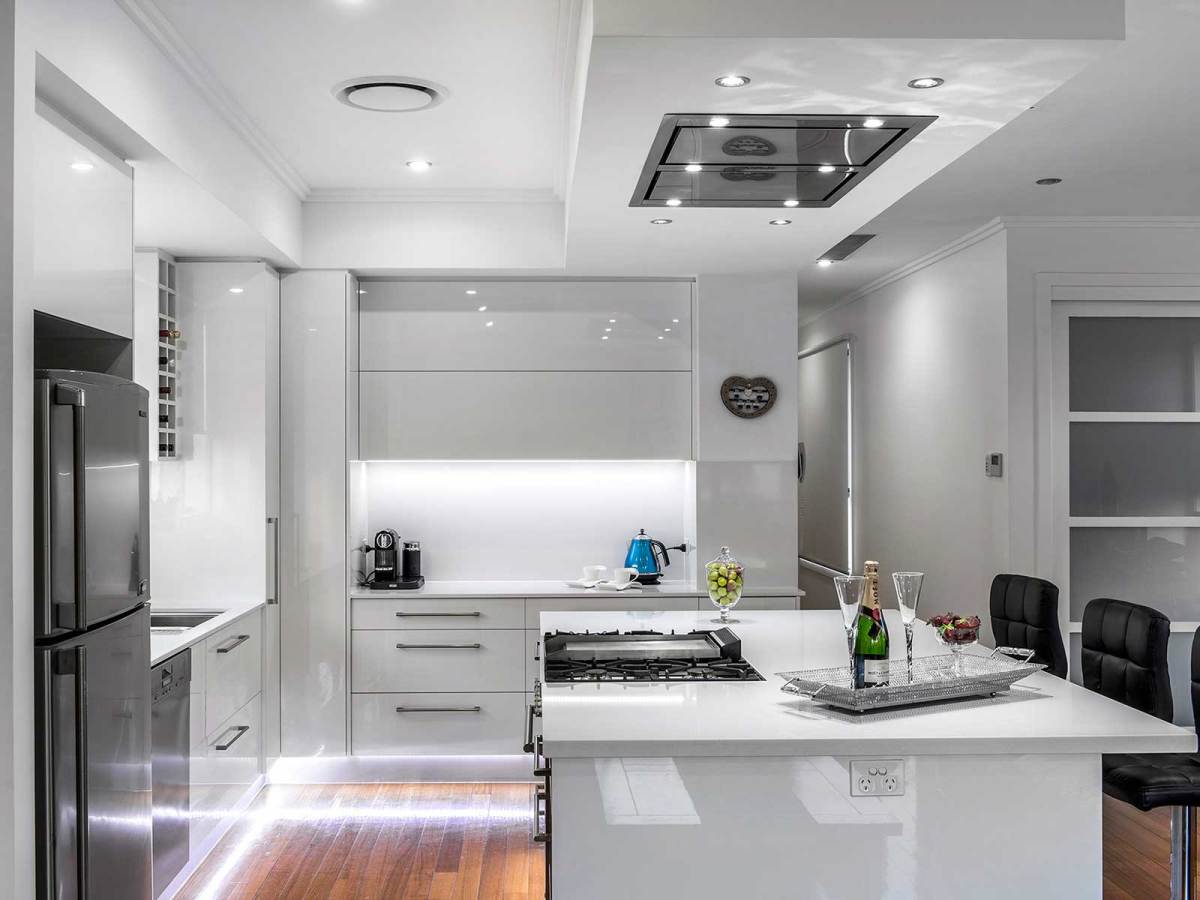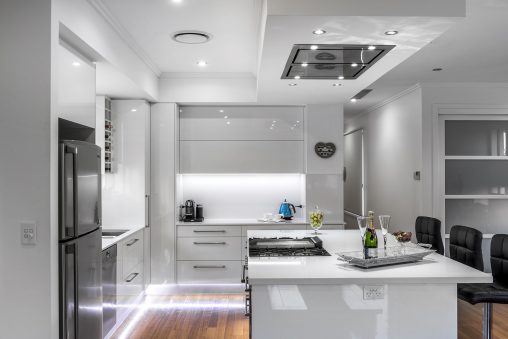
- On the aesthetic front, two trends are occurring simultaneously: the statement piece versus the rangehood integrated into cabinetry or ceiling.
- The popularity of open plan living means that the rangehood has greater importance when it comes to removing odours and cooking residue, and doing the job quietly.
- Correct installation and ducting of a rangehood are essential for getting the most out of the product.
The open plan aesthetic where the kitchen integrates with living and dining areas has become extremely popular in Australian homes. The humble rangehood has quite a role to play in this modern floor plan, either as a statement piece in a minimalist design or by disappearing almost completely into the roof or bench cabinetry.
When it comes to buying rangehoods, consumers fall into one of two broad camps: those who are looking for a statement piece in the kitchen and those who prefer the rangehood be neither seen nor heard. More and more, suppliers are offering deep ranges of models to cater for both crowds.
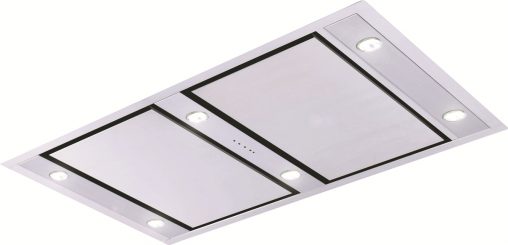
Anthony Fletcher, director and CEO of Schweigen Home Appliances, said the typical Australian home is currently in a phase of change.
“Gone are the days where our kitchens are separated from the heart of our homes and not given much thought. With a large percentage of modern houses as well as renovated homes now incorporating open plan kitchens, the kitchen is quickly becoming the nucleus of every home,” he said.
It’s a trend that makes sense as dining and entertaining have always gone hand-in-hand.
“The rise of open plan living areas means that we now have specific requirements and needs when it comes to our kitchen and its appliances.”
“A modern kitchen should be seen and not heard. Be practical but not invasive. Stylish yet at the same time discreet. A modern kitchen then needs to combine aesthetics, functionality and subtlety all in one,” Fletcher said.
In Schweigen’s Silent Ceiling Rangehoods, the motor is removed from the canopy and positioned outside the home. This ensures silent extraction inside your kitchen while being able to sport powerful German-made motors that can handle any cooking needs.
“Combine this with stylish and timeless rangehood designs and you have the ultimate modern rangehood.”
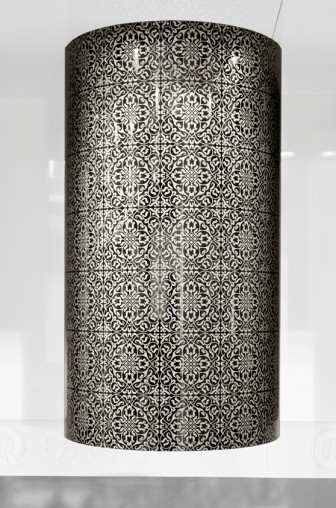
Distributor of Qasair and Condor rangehoods, Condari plans to bring a launch a new brand of rangehoods called Rangecraft in Australia in the second half of 2014. The Rangecraft unit are manufactured by Condari, a wholly Australian owned company, in Melbourne.
Condari expects the Rangecraft rangehoods range to revolutionise the recirculating market with a product that doesn’t require ducting but is very efficient and effective in the removal of the by-products of cooking.
Condari director John Keating explains the technology behind the Rangecraft rangehoods’ air cleansing.
“Rangecraft is a revolutionary ventilation system that utilises a plasma system to convert odour molecules into odourless water, oxygen and carbon dioxide, thereby cleansing the air,” Keating said.
“Plasma technology is derived from the space industry where the need for clean air is imperative. We see wide and growing applications for the Rangecraft Rangehoods where ducting a rangehood is unfeasible.”
Along with the introduction of the Rangecraft models, Keating said the second half of the year will see improvements in the current Qasair range with rangehoods becoming quieter with better insulation. “Condari has spent hundreds of thousands of dollars on research over the years at the CSIRO to continuously improve the quality of our products,” he said.
One such series of rangehoods is the Sapphire range from Qasair, made from chemically etched stainless steel to give it a coloured and textured finish. It is also quiet, with a decibel rating of between 37 and 55, and the filters can be cleaned in the dishwasher.
Keating said retailers should carefully choose supply partners that are high in quality and value and also offer good after-sales service.
“In the kitchen appliances and whitegoods market there has been an oversupply of brands, which has not been an advantage to the industry. Retailers have been trying to support too many different brands, giving rise to the situation where suppliers are under-supported and sales staff are left baffled by the number of products that they must have knowledge of,” he said.
“Additionally, this oversupply has not been of any benefit to the consumer as they are faced with an increased number of choices with no real difference in the quality of the selections,” he said.
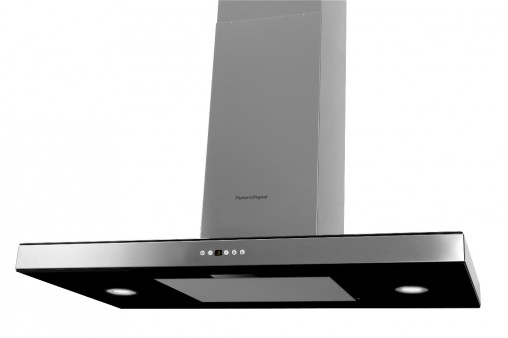
Fisher & Paykel marketing manager, Kara May said the two trends in rangehood design, to stand out or blend in, are happening concurrently.
“Consumers’ desire to conceal kitchen appliances, either by integrating with cabinetry or by choosing a streamlined, minimalist and/or compact model, extends to rangehoods,” she said.
To cater for the consumer wanting an uninterrupted kitchen look, Fisher & Paykel has the PowerPack Rangehoods, which fit underneath overhead cupboards.
“Parallel with the trend to subtly blend open kitchens with living areas, runs another popular style towards traditional, commercial-style kitchens that command attention in their own right. Where people have the space and the culinary inclination, they often choose an Island Rangehood as a dramatic central showpiece,” May said.
Regardless of style, enhanced performance is paramount for rangehoods, May said. “All of Fisher & Paykel’s ventilation products, including the minimalist models, are built to perform. Both rangehoods and canopies are easy to use and feature intuitive controls that respond to the touch of a finger, effectively capturing and eliminating cooking odours, vapour and steam.”
Fisher & Paykel’s VentSurface rangehood senses vapours, odours or steam created by cooking and automatically turns itself on. During cooking, the VentSurface adjusts its fan speed according to the amount of vapour sensed, and then turns itself off when the job is done.
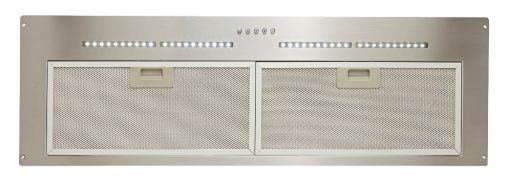
When it comes to major kitchen appliances, Smeg believes that no one design can satisfy all tastes and this extends to rangehoods. The brand has a portfolio of 64 rangehood models to accompany its cookers. Smeg offers a choice of island, wall, ceiling and benchmounts in canopy and concealed configurations in a choice of styles including stainless steel, black, panna enamel, white and crystal glass.
While Smeg believes rangehoods are integral to a well-functioning, clean kitchen, it also recognises their value to the retailer as an easy add-on sale. The brand said it has seen strong sales across all categories of rangehood in the past twelve months but the emerging trend is definitely towards the built-in concealed hood.
“Sales of the concealed rangehood are continuing to grow very strongly, an indication, we think, that consumers are choosing to use other appliances as their visual statement-piece so want the rangehood to take a more understated role in the kitchen,” said Jim Kalotheos, national marketing manager, Smeg Australia.
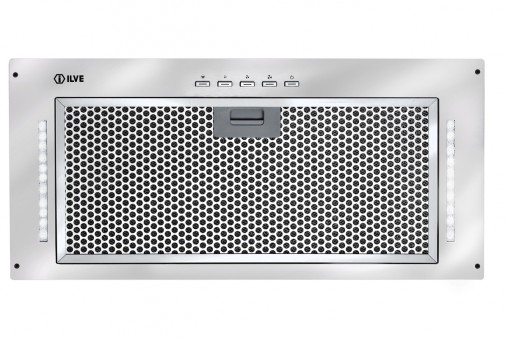
Eurolinx, distributor of ILVE and De Dietrich, marketing manager Daniel Bertuccio tells a similar story, saying he too is seeing a continued trend toward concealed rangehoods.
“Consumers are taking the out of sight, out of mind method with these products. Both ILVE and De Dietrich have concealed hoods available that we are very excited about with more to come this year,” Bertuccio said.
Rather than setting out to become trend forecasters in the rangehood category, the Eurolinx strategy is to offer ranges to complement its cooking models.
“The rangehood market is a hard one to predict, with so many different styles and sizes available, we have decided not to focus on one particular style and have instead decided go to market with a selection of products that perfectly complement our cooking products for both brands, ILVE and De Dietrich,” Bertucci said.
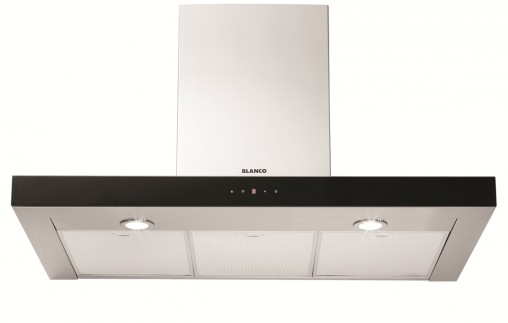
Lisa Hill, advertising and promotions executive for Blanco, said rangehoods are one of the most important things in the kitchen but are often the last thing people think about when renovating or building. Today rangehoods have aesthetic and functional criteria they need to fulfill, she added.
“While rangehoods are often considered a statement piece in the kitchen, they also perform the important function of removing unwanted odours, grease and smoke while trapping food particles that may be in the air from cooking,” Hill said.
Hill said the Blanco BWC90TB canopy rangehood (RRP $1,199), with its sleek black glass fascia, showcases the beautiful European design but does not overpower, allowing it to blend into the kitchen. It also has a high extraction rate, four speeds, auto-off timer and filter saturation warning.
“As the kitchen becomes the hub of the entertaining space, it is important to have a rangehood that cleans the air with both efficiency and silence,” Hill said.
A notable Blanco feature is the Clean Air function that can be activated to switch the motor on for 10 minutes every hour at the first speed setting.
“This function is ideal to turn on after cooking to keep the air circulating and to ensure any residual smells or cooking odours are removed, and with a low decibel rating, you can carry on entertaining without interruption,” Hill said.
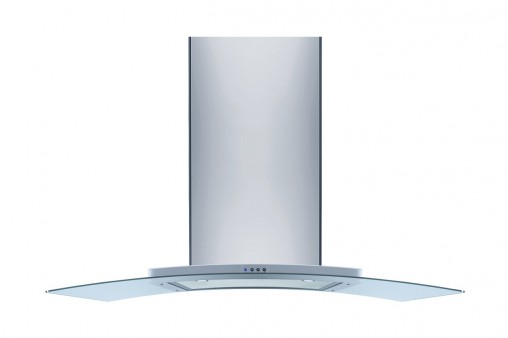
Darren Sharvell product development manager for Omega said Omega currently markets telescopic, fixed, undermount and various canopy options, with a focus on high extraction rates.
“At Omega, we understand that cooking, cleaning and washing aren’t your favourite things in the world. That’s why we created a range of no-nonsense, reliable products that always get the job done for you, with the features you need and nothing you don’t,” Shervell said.
Omega’s hero product is the 90-centimetre Stainless Steel and Glass Wall-Mount Chimney Rangehood (ORC97G RRP $799).
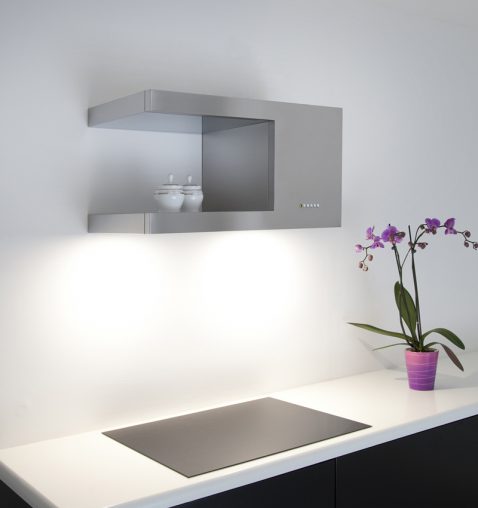
Rachael Williams, national sales and marketing for specialist brands at Arisit, which distributes Sirius rangehoods, said that the market is seeing a big swing toward ceiling cassettes and island downdrafts.
“Induction-friendly hoods are also in big demand as retailers are experiencing customers’ reports of having condensation dripping back onto the hob during cooking, which can happen when a non-suitable model has been installed.
“Undermount hoods are still pushing forward to gain market share over slide out or three flare canopy hoods, which previously held this category and price point,” she said.
Another trend in the market Williams has noticed is that more and more cooking brands are offering rangehoods as consumer give-aways or combined into package promotions with the ovens and hob.
“This can mean consumers are buying or being given under-powered or unsuitable hoods not appropriate to the customer’s specific needs. It also means the retailers are missing the margin opportunities on hood sales.”
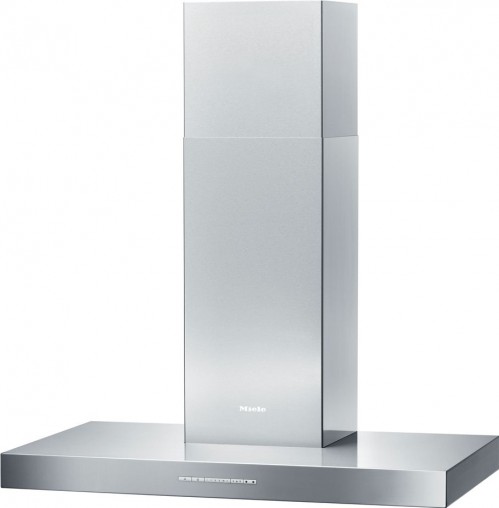
Thorsten Kissel, product manager for food and beverage preparation at Miele Australia, said consumers need to be wary of a rangehood’s effectiveness when adopting a “full integration” kitchen design.
“For example, downdraft units, become less effective with tall pots during a rolling boil. While many installations of ceiling extractors will be challenged by too large a distance from the hob, causing vapours to be dispersed in the room before they are extracted,” he said.
“As a consequence, it is important to match usage requirements with the product performance attributes.” In this instance, Miele offers the DA 6596 CANTO model (RRP $3,199), which is a specific model equipped to deal with cooking vapours above an induction cooktop.
It comes pre-equipped with Miele’s exclusive Con@ctivity 2.0 function, which allows the matching induction cooktop to communicate with the rangehood for convenient hands-off operation. Thanks to a set of stainless steel filter covers, the DA 6596 CANTO model not only catches vapours as they travel upwards, but also away from the pot.
The leading downdraft brand on the market is Bora. Managing director Markus Ostermaier rejected this criticism of the technology, saying it has significant advantages over traditional form factors.
“Extractor hoods in the kitchens are loud, not very effective, and they block your view,” he said. “They take up precious space and can become an unwanted centrepiece. Furthermore, they reduce your design possibilities when you’re planning a kitchen.”
Ostermaier says this is important because, “The kitchen of today has not just been reserved for cooking for a long time. It’s for get-togethers, enjoying great culinary moments with each other and having stimulating discussions. It has become a living space, the central meeting place of our time.”
Bora sells the complete benchtop package in one: both the cooktop and the downdraft extraction system. The Classic Extractor System (CKAS, RRP $3,599) includes an induction glass ceramic cooktop, including a wok hob, and can be flush mounted into a counter as narrow as 60 centimetres.
“Bora offers your customers more flexibility and opens up new possibilities when it comes to kitchen planning. We produce high-quality products that are good for people and beneficial for the environment. In this way, we enrich the time one spends in the kitchen, improve your quality of life, and make kitchen dreams come true.”
Bosch offers a wide selection of rangehood models to accommodate consumer preferences, according to product manager Monica McCormack.
In its canopy range, Bosch has introduced LED lighting and a noise-reducing EcoSilence BLDC motor. The brushless motor eliminates friction making it more energy efficient and quieter operation.
Bosch’s 90-centimetre Wall-Mounted Stainless Steel Canopy Rangehood (DWB097E50A, RRP $1,499) has three power settings for cooking and a fourth and fifth setting to control smoke and steam. The LED lights can also be dimmed, to create ambient lighting in the kitchen.
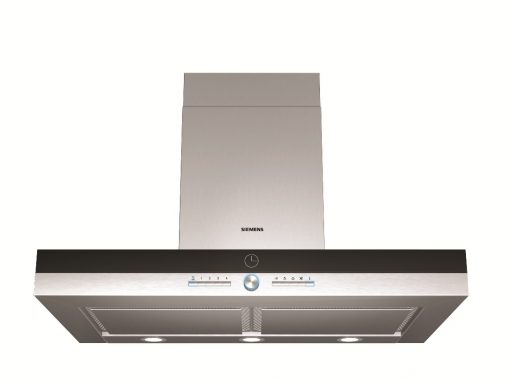
Over at stablemate Siemens, marketing communications manager Roberto Finamore said, “A kitchen is not complete without an efficient rangehood to protect against condensation, grease and cooking odours.
“Siemens rangehoods have been designed to complement and blend in seamlessly with the kitchen appliances whilst being efficient and quite.”
The Siemens 90-centimetre Wall-Mounted Canopy Rangehood (LC958BA90P RRP $3,149) boasts quite operation and has additional sound insulation mats for optimised sound absorption.
